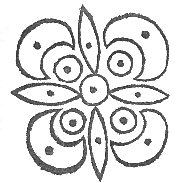From the late 16th century it was common to decorate tarts by removing the lid after baking and replacing it with an intricate pattern made from rich puff paste. The spaces in between were filled with preserves of contrasting colours (Brears 1991, 91). Designs for these tarts were published by Robert May in 1660, in a cookbook entitled The Accomplisht Cook. Little pieces of pastry could be cut to resemble flowers, tulips, birds and any other shapes such as leaves, crescents, wheels or diamonds. The shapes were cut by tracing round flat tin patterns with an edging iron. The housewife could also use cylindrical earthen or metal pie moulds that impressed or raised designs on the walls of standing pies.

Figure 16: Pattern for cut pastry. From Robert May The
Accomplisht Cook 1660, 220 (Vehling Collection, Cornell
University Library)
© Internet Archaeology URL: http://intarch.ac.uk/journal/issue16/1/ch6.38.html
Last updated: Wed Mar 24 2004